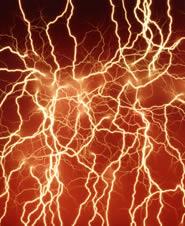 Mathematics explains lightning's forked tongues.© GettyImages
Mathematics explains lightning's forked tongues.© GettyImagesJagged forks of lightning resemble the dividing course of streams because their underlying mathematics is similar, say Netherlands researchers. Their work explains why lightning tongues take on the favourite branching pattern of nature.
The streamers of glowing, ionized gas in a lightning strike have an inevitable tendency to break up at their tips, creating a familiar tree-like pattern. This 'tip-splitting' is the same kind of process that gives rise to branching in snowflakes and river channels, say Manuel Arrayas and colleagues at the National Research Institute for Mathematics and Computer Science in Amsterdam1.
Their study shows how natural phenomena often derive their patterns from a relatively limited palette. The striped ripples of sand dunes, for example, mirror the stripes of a zebra because both pattern formation processes are governed by the same equations.
The parallel between different natural branching patterns has been long recognized. The similarity between diverging streams and networks of blood vessels may have encouraged Leonardo da Vinci to regard rivers as the 'blood of the earth'. But only recently have scientists been able to show that these are more than chance resemblances.
In the 1980s, researchers identified a process called Laplacian growth which explains why branching occurs at the boundary between two substances. These include the formation of some mineral structures, cracks, and fingering patterns when air or water are injected under pressure into viscous oil. Any tiny bulge that appears by chance at the boundary between the two will rapidly become a long, thin branch - this is called a Laplacian instability.
Arrayas and colleagues have shown that a Laplacian instability also occurs at the edge of a lightning streamer: a moving column of electrically charged gas. Streamers discharge mounting electrical charge from a thundercloud by allowing a flow of electricity to the ground. Using computer simulations, the team found that a streamer undergoes spontaneous branching at the tip. The equations describing this splitting are the same as those that produce branched Laplacian growth in other systems.
A simple model of electrical sparking, which generates branched patterns, was developed by researchers in Switzerland in 1984; but the new work is the first to show how these patterns arise from the formation and movement of ions and free electrons in ionized air.
Strike rate
Meanwhile, US researchers have made the first estimates of how much electrical energy thunderclouds can store up - and how many lightning strikes it takes to discharge it2. Thomas Marshall and Maribeth Stolzenburg of the University of Mississippi found that some kinds of strike are much more energetic than others, and that the type of strike is determined by the way charge is distributed within the cloud. Some clouds can hold up to one-twentieth the energy of the Hiroshima atomic bomb - but it is typically released in hundreds or thousands of separate strikes.
-
References

